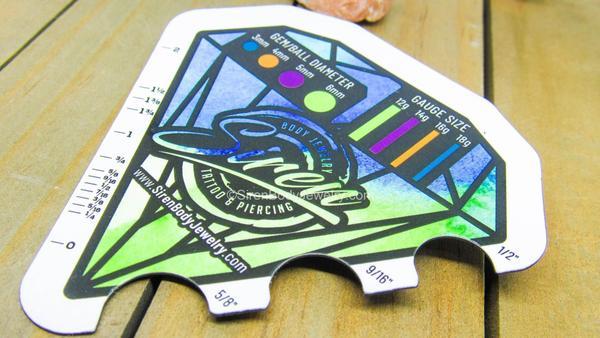We love online shopping, but when it comes to body jewelry, there are a few things you should know before ordering.
When shopping for body jewelry online, it' important to know your specific sizing needs. Without this information, ordering can be a frustrating process. Not only can you waste your own time and money, but you just might order body jewelry that isn't right for your specific piercing. Not exactly a fun scenario.
A valuable tool to have is our measuring magnet, it makes measuring for gauge thickness a breeze.
Let's dive right into body jewelry gauge sizing.
When it comes to the thickness of the piece, we refer to its gauge.
Gauge Sizes: (thin to thick)
- 20g
- 18g
- 16g
- 14g
- 12g
- 10g
- 8g
- 6g
- 4g
- 2g
- 0g
- 00g
After 00g, we then refer to the thickness in inches:
- 1/2"
- 9/16"
- 5/8"
- 3/4"
- 1" and up.
There are some in between sizes, but they are not quite as common. 1g is just one example, and this gauge thickness is typically found in ear stretching jewelry like eyelets, tunnels, plugs and tapers.
20g is the thinnest in our example, the rest follows as thicker...18g, 16g, etc.
The word "gauging" refers to the action of stretching up a piercing, for example an earlobe.

Body jewelry that is used to stretch can be referred to as a plug, eyelet, single flare, double flare, tunnel or taper.
You may hear someone say,
"I'm gauging my ears to 4g, do you have any 4g plugs?"
Gauging is synonymous with stretching in this phrase, 4g describes how thick and plugs refer to the body jewelry to be inserted needing to be a size 4g. In this case, plugs refer to a piece of jewelry that has no hole in the center.
If you're stretching up from a 6g to a 4g, 4g is thicker in gauge (larger). Therefore, you'll need a 4g taper to help increase your gauge size from 6g to 4g.
Alternatively, natural ear stretching may not involve the use of a taper at all.
For example, many clients choose to use single flare glass or natural stone plugs with O rings to stretch slowly over time. This allows the body to progress into large gauge sizes as it will allow. Each individual client may progress over different timelines which can span 6 months or more. Patience is key with natural stretching methods.
Most commonly, tapers are used to assist in the stretching process. A taper used to stretch will have a matching gauge thickness as the jewelry to be inserted.
For example,
When stretching your earlobe from an 8g to a 6g, you'll need to have a 6g taper and a set of 6g body piercing jewelry like plugs, tunnels, labrets or captive bead rings.
Let's review what we have learned.
- Gauge refers to the thickness.
-
The word "gauging" refers to the action of stretching up a piercing, for example an earlobe.
- When stretching or increasing your gauge thickness a taper or natural method can be used.
- Most commonly, tapers are used to assist in the stretching process.
Gauge sizing can be difficult to easily grasp at first glance, but over time, you'll have it down. It's a good practice to refer to a gauge sizing chart. Understanding the different methods used to increase gauge size to insert body jewelry allows you to order with confidence and minimize ordering errors when shopping for body jewelry online.


